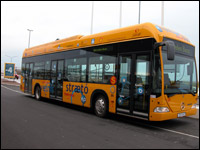
The loneliness of the long-distance rider.
I have seen the future, and it works.
The 111 bus rolls quietly up to the Mjodd terminal in eastern Reykjavik at 11:19 a.m., and I climb aboard. For 45 minutes, we cruise through the suburbs and then to the central square downtown, picking up and discharging eight passengers along the way. Fuel cells that would have filled the space of several passenger seats five years ago are now small enough to fit in the roof panels. And out the exhaust pipe: a trickle of water.
This is one of three hydrogen buses added to the streets of Iceland’s capital, as part of a pilot project with nine other European cities. “We have tested and tested, and we have learned and learned,” Hordur Gislason, a bus-system manager, tells me. “And what we have learned is — they function smoothly. In the beginning we had to stop them often for repairs, but as time went by they became [more and more] stable.
“You could drink the water that comes out of the tailpipe,” Gislason continues. “You wouldn’t want to — but in an emergency!”
Though the first buses were custom-made, Gislason predicts they’ll be mass-produced 10 years from now. Which is about the right timeline. Iceland has announced a goal of being entirely fossil-fuel free by 2050 — converting an entire nation (albeit a small one, of just under 300,000 souls) to a hydrogen economy.
It is incredibly moving to stand next to the pumps at the world’s first commercial hydrogen filling station. (In mid-June, the “Hydrogen Puffin,” a motorized tricycle, fueled up there for a circumnavigation of the island to draw attention to the new fuel’s possibilities.) The display signs from the E.U. consortium funding the project announce as obvious truth those axioms my own nation, the U.S., is still unwilling to hear: “Fossil-based fuels will eventually run out”; “Governments are under pressure to meet internationally agreed emissions targets.” You think: maybe this is doable. Maybe there really are some silver bullets out there that will help us wean ourselves off fossil fuels before it’s too late.
And then you think some more.

Rollin’ in Reykjavik.
Photo: Icelandic New Energy.
For one thing, hydrogen makes enormous sense — in Iceland. Because Iceland is, in essence, a nation-sized science-fair project. Everything is steaming, puffing, erupting, geysering. This means there’s an almost inconceivable amount of renewable energy waiting to be tapped.
So far it’s mostly used to make electricity — a power source so cheap that some major international aluminum smelters have relocated here. But that electricity can in turn be used to make hydrogen. Passed through water, it strips the element out, allowing it to become usable fuel for buses or cars or anything else. In most of the rest of the world, people who talk about a hydrogen economy are talking about using some hydrocarbon — natural gas, usually — as their feedstock. Better than driving around on oil, but not incredibly better.
You can imagine renewable systems elsewhere — the solar panel on your roof, the windmill on the ridge — making the clean electricity needed to produce hydrogen, but for a long time to come that clean electricity will be needed simply to displace the dirty electricity we’re already making. Not only that, but Iceland’s compact size — there’s one city, and the rest of the nation’s population mostly lives right off a single coastal ring road — means that building a network of filling stations is a considerably smaller challenge than, say, converting the United States.
There’s a deeper problem, too, one that’s visible on the 111 bus: most of the time I have it to myself. Not because it’s a hydrogen bus. Because it’s a bus. This is a brilliant public-transportation system — its 100 buses are 97 percent on time, clean, comfortable. (Reykjavik’s drivers just won the Nordic bus-driving championship for the fourth straight year, and the individual champion, Markus Sigurdsson, is one of the hydrogen pilots.)
“The problem is more to have people appreciate it,” says Gislason. “The buses are used, but we can’t say heavily used. Icelanders can afford a car … And we went pretty much from the individual horse into the private car.” Indeed, many Icelanders have a pair of cars: something small and sensible for the commute, and something big for driving on the many dirt and ice roads of the country’s interior highlands.
Not only that, but as the economy has boomed in recent years (genetics is the new gusher), Reykjavik has sprawled. Not quite American-style, but still. As Gislason stands at the filling station, he points at the horizon: “There’s part of Reykjavik here, and part over there, and now a new part over there.” The parliament is considering legislation to encourage what an urban planner would call “infill,” and it’s possible to imagine it passing — this was the first nation in the world, after all, to take fishing quotas seriously. But it doesn’t make it any easier to run a bus company.
“We have a European standard of bus service,” says Gislason, “but we have the American syndrome of the private. That’s our case.”
In some ways it’s the world’s case. Will China and India and the rest of the developing world tilt toward a European mix of public and private, or toward the American denigration of everything communal, be it buses or medical care? If there were technological silver bullets, it might not matter — if we all had vast geothermal reserves to cleanly provide as much energy as we wanted, then it’s possible to imagine an SUV future. But since we don’t, culture will matter as much as technology.
Which is to say, a hydrogen bus is a neat trick. But a full bus, no matter what it’s burning, is an even better one. I’ve seen the future, and it works — but only if you climb on board and pay your fare.


